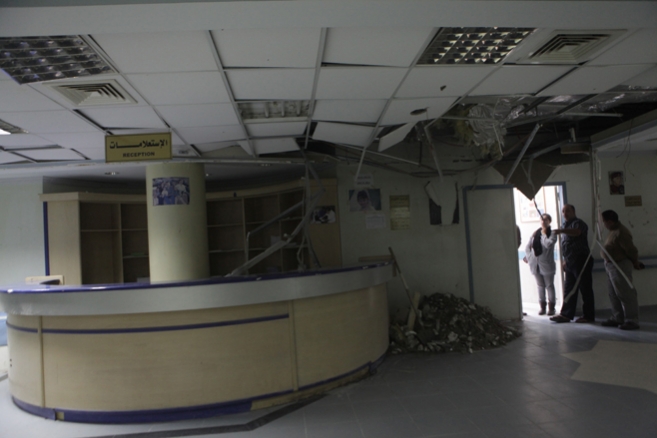
An Israeli Hellfire missile struck the Jordanian Military Field Hospital in Gaza City on November 19, 2012, puncturing the roof and cutting electricity and water lines. © 2012 Anne Paq/Human Rights Watch
Two days ago, Human Rights Watch (HRW) published the findings of a detailed investigation it had conducted into Israeli airstrikes on Gaza in November 2012. At least 43 Palestinian civilians, including 12 children, were killed in these attacks, in apparent violation of international humanitarian law.
The report ‘Israel: Gaza Airstrikes Violated Laws of War: Israeli Attacks Killed Civilians, Destroyed Homes Without Lawful Justification‘ documents grave harm to civilians caused by the use of different types of explosive weapons, in densely populated areas in the Gaza strip.
At least seven of the investigated airstrikes appeared to involve aerial drones launching guided missiles (Hellfire missiles), and at least four appeared to involve fixed-wing aircraft dropping aerial bombs.
In one case, a Hellfire missile strike that may have been targeting the home of a member of a Palestinian armed group, caused the death of at least three civilians and wounded at least 20 others, many of them outside on a crowded street.
The attack took place in the late afternoon of 20 November, when two Hellfire missiles struck a second-story apartment on Baghdadi Street in Shaja’iya. The strike killed Yusra Shawa, 18, and badly injured her mother, Mona Shawa, 47. Mona Shawa remembers:
Yusra was watching TV with me, sitting close together, and our three boys were out on the street. Then the missiles hit. I didn’t hear the explosions, I just saw rubble and dust. I tried to call out for her but I couldn’t see her. I refused to leave the house before they found her. …I learned later that shrapnel entered her head and killed her.
The explosions also killed three people in the street below. Mahmud Zohri, a 21-year-old motorcycle mechanic, was standing several dozen meters away outside a supermarket where he was buying food. He suffered fatal internal blast injury. Shrapnel from the strikes killed Tareq al-Hjeilah, 40 co-owner of a telecom shop and father of four boys. He was one door away from the building that was hit, when shrapnel entered his neck and hit his heart. Fragments projected by the second missile strike hit Saqer Bulbul, 57, on his back, neck and head.
In addition, fragments of the missiles wounded more than 20 people who were on the street, at least two seriously. One of Bulbul’s sons, Mohamed, 14, had been standing next to his father at the time of the attack. Mohamed was lightly wounded in the neck. He still has frequent nightmares about the attack.
HRW is a founding member of the International Network on Explosive Weapons (INEW).
INEW notes that the report demonstrates that explosive weapons can affect a wide area around the point of detonation with blast and fragmentation. Due to the unacceptable risk this poses to civilians in the vicinity of the explosion, such weapons should not be used in populated areas.
INEW calls on states and other actors to
− Acknowledge that the use of explosive weapons in populated areas tends to cause severe harm to individuals and communities and furthers suffering by damaging vital infrastructure;
− Strive to avoid such harm and suffering in any situation, and recognise the need to end the use of explosive weapons with wide area effects in populated areas;
− Review and strengthen national policies and practices on use of explosive weapons, develop stronger international standards;
− Gather and make available relevant data, work for the full realisation of the rights of victims and survivors.
